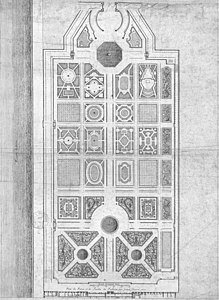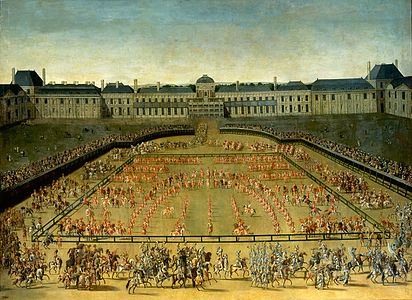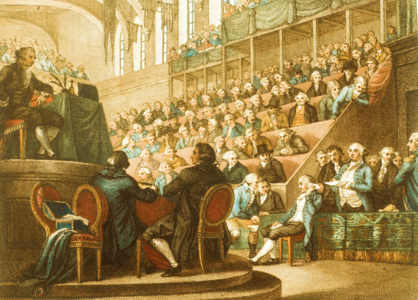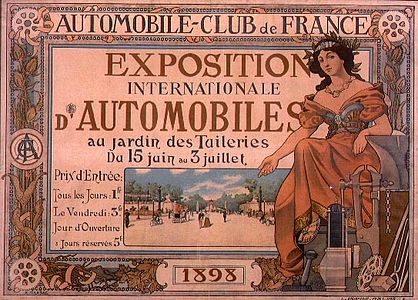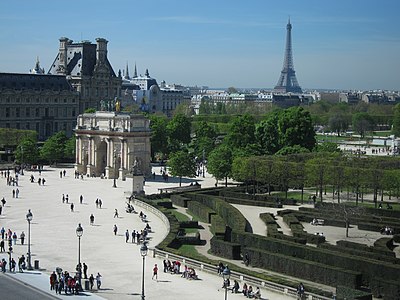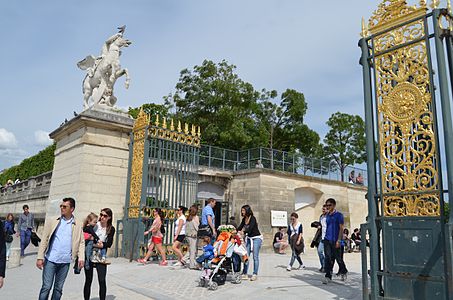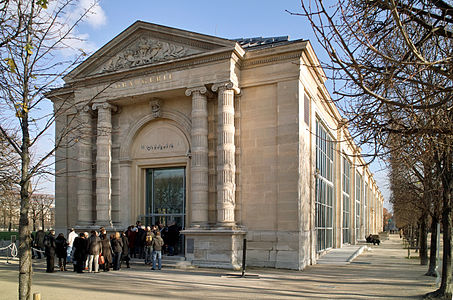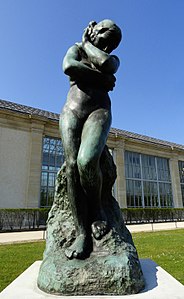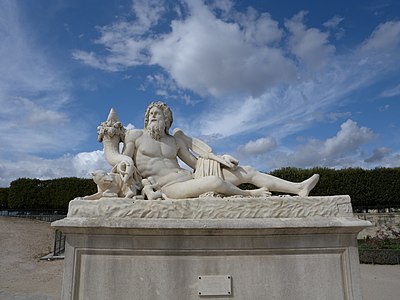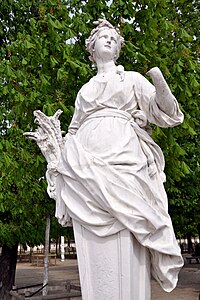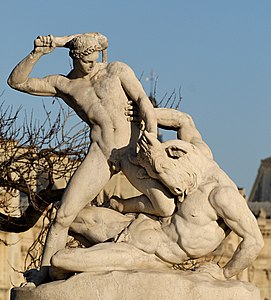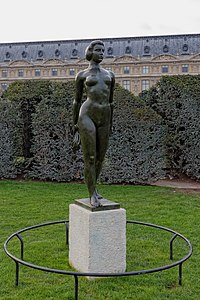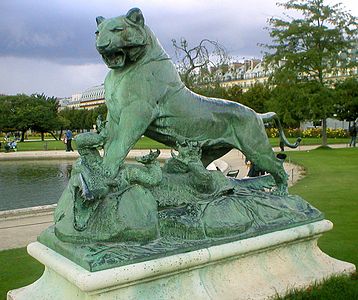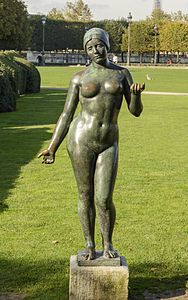Tuileries Garden
| Tuileries Garden | |
|---|---|
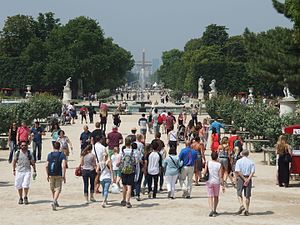 Grande Allée of the Tuileries Garden, looking towards the Place de la Concorde and the Arc de Triomphe | |
 | |
| Type | Urban park |
| Location | Paris,France |
TheTuileries Garden(French:Jardin des Tuileries,IPA:[ʒaʁdɛ̃detɥilʁi]) is a public garden between theLouvreand thePlace de la Concordein the1st arrondissement of Paris,France.Created byCatherine de' Medicias the garden of theTuileries Palacein 1564, it was opened to the public in 1667 and became a public park after theFrench Revolution.Since the 19th century, it has been a place for Parisians to celebrate, meet, stroll and relax.[1]
History[edit]
The Italian Garden of Catherine de' Medici (16th century)[edit]
-
Plan for the palace and gardens byJacques I Androuet du Cerceau,1576–1579
-
Plan of the Tuileries garden in about 1589. The Louvre is to the right
In July 1559, after the accidental death of her husband,Henry II,QueenCatherine de' Medicidecided to leave her residence of theHôtel des Tournelles,at the eastern part of Paris, near theBastille.Together with her son, the new king of FranceFrancis II,her other children and the royal court, she moved to theLouvre Palace.Five years later, in 1564, she decided to build a new residence with more space for a garden. For that purpose, Catherine bought land west of Paris, just outside the cityWall of Charles V.It was bordered on the south by theSeine,and on the north by thefaubourg Saint-Honoré,a road in the countryside continuing theRue Saint-Honoré.Since the 13th century this area had been occupied by tile-making factories calledtuileries(from the Frenchtuile,meaning "tile" ). The new residence was called theTuileries Palace[2][missing long citation]
Catherine commissioned a landscape architect from Florence, Bernard de Carnesse, to create anItalian Renaissance gardenfor the palace. The new garden was an enclosed space five hundred metres long and three hundred metres wide, separated from the new palace by a lane. It was divided into rectangular compartments by six alleys, and the sections were planted with lawns, flower beds, and small clusters of five trees, calledquinconces;and, more practically, with kitchen gardens and vineyards.[3]It was further decorated with fountains, alabyrinth,agrotto,andfaienceimages of plants and animals, made byBernard Palissy,whom Catherine had tasked to discover the secret of Chineseporcelain.
The development of the garden was interrupted by a civil war. In 1588Henry IIIhad to flee through the garden to escape capture from theCatholic Leagueon theDay of the Barricadesof theFrench Wars of Religionand did not return. The gardens were pillaged. However, the new king,Henry IV,returned in 1595 and, with his chief landscape gardenerClaude Mollet,restored and embellished the gardens. Henry built a chamille, or covered arbor, the length of the garden, Another alley was planted withmulberrytrees where he hoped to cultivatesilkwormsand start a silk industry in France.[3]He also built a rectangular ornamental lake of 65 metres by 45 metres with a fountain supplied with water by the new pump calledLa Samaritaine,which had been built in 1608 on thePont Neuf.The area between the palace and the former moat ofCharles Vwas turned into the "New Garden" (Jardin Neuf) with a large fountain in the center. Though Henry IV never lived in the Tuileries Palace, which was continually under reconstruction, he did use the gardens for relaxation and exercise.[2]
Garden of Louis XIII and Louis XIV – The French formal garden (17th century)[edit]
-
Garden of Louis XIII in 1649–51
-
Tuileries Garden of Le Nôtre in the 17th century, looking west toward the future Champs-Élysées, engraving byGabriel Perelle
-
Le Nôtre's Tuileries Garden plan, engraving byIsraël Silvestre,1671
-
The Carrousel of 5–6 June 1662 at the Tuileries, celebrating the birth of Louis XIV's son and heir
In 1610, at the assassination of his father,Louis XIII,age nine, became the new owner of the Tuileries Gardens. It became his enormous playground - he used it for hunting, and he kept a small zoo of exotic animals. On the north side of the gardens, his mother and the regent,Marie de' Medici,built stables and a riding school, theManége,which survived until the French Revolution, when it was used as the meeting hall of the revolutionary parliament.
The garden was entirely enclosed, and was used exclusively by the royal family when they were in residence, but When the king and court were absent from Paris, the gardens were turned into a pleasure spot for the nobility. In 1630 aparterreat the west end of the garden, between the Louvre and the Tuileries Palace, where the moat of the old city walls had been, was turned into a parterre of flower beds and paths. This parterre was transformed into a sort of a playground for the aristocracy. The daughter ofGaston, Duke of Orléansand the niece of Louis XIII, known asLa Grande Mademoiselle,held court there, and it became known as known the "Parterre de Mademoiselle". However, in 1652, "La Grande Mademoiselle" was expelled from the palace and garden for having supported an uprising, theFronde,against her cousin, the youngLouis XIV.Louis XIV had the space transformed into large parade ground, When his first child was born, on Jun 5-6 1662, the parterre was the setting for a spectacular circular horseback promenade by the nobility, slowly circling the parterre. This became known as a "Carrousel",and gave its name to that portion of the garden.[4]
Louis XIV quickly imposed his own sense of order on the Tuileries Garden. His architects,Louis Le VauandFrançois d'Orbay,finally finished the Tuileries Palace, making a proper royal residence. In 1664,Colbert,the King'ssuperintendent of buildings,commissioned the landscape architectAndré Le Nôtre,to redesign the entire garden. Le Nôtre was the grandson of Pierre Le Nôtre, one of Catherine de' Medici's gardeners, and his father Jean had also been a gardener at the Tuileries. He immediately began transforming the Tuileries into a formaljardin à la française,a style he had first developed atVaux-le-Vicomteand perfected atVersailles,based on symmetry, order and long perspectives.
Le Nôtre's gardens were designed to be seen from above, from a building or terrace. He eliminated the street which separated the palace and the garden, and replaced it with a terrace looking down upon flowerbeds bordered by low boxwood hedges and filled with designs of flowers. In the centre of the flowerbeds he placed three ornamental lakes with fountains. In front of the centre of the first fountain he laid out the Grande Allée, which extended 350 metres. He built two other alleys, lined with chestnut trees, on either side. He crossed these three main alleys with small lanes, to create compartments planted with diverse trees, shrubs and flowers.
On the south side of the park, next to theSeine,he built a long terrace called the Terrasse du bord-de-l'eau, planted with trees, with a view of the river. He built a second terrace on the north side, overlooking the garden, called the Terrasse des Feuillants.
On the west side of the garden, beside the present-day Place de la Concorde, he built two ramps in a horseshoe shapeFer á Chevaland two terraces overlooking an octagonal lakeBassin Octogonal60 m (200 ft) in diameter, respectively 70 m (230 ft) from corner to corner, with one fountain in the centre with a waterjet of 12 m (39 ft) height, additional powerful waterjets from each corner to the center. The terraces frame the western entrance of the garden, and provide another viewpoint to see the garden from above.
Le Nôtre wanted his grand perspective from the palace to the western end of the garden to continue outside the garden. In 1667, he made plans for an avenue with two rows of trees on either side, which would have continued west to the present Rond-Point des Champs-Élysées.[5]
Le Nôtre and his hundreds of masons, gardeners and earth-movers worked on the gardens from 1666 to 1672. In 1682, however, the King, furious with the Parisians for resisting his authority, abandoned Paris and moved to Versailles.
In 1667, at the request of the famous author ofSleeping Beautyand other fairy tales,Charles Perrault,the Tuileries Garden was opened to the public, with the exception of beggars, "lackeys" and soldiers. It was the first royal garden to be open to the public.[6]
Louis XV and Louis XVI – balloon flights, an invasion, and revolutionary ceremonies[edit]
-
First flight of a hydrogen-filled balloon from garden on 1 December 1783
-
Fighting in the Tuileries Garden and massacre of Swiss Guards, 10 August 1792
-
Louis XVI makes his plea at his trial, in theSalle du Manège,or riding school in the gardens, 26 December 1792
-
Ceremony of theCult of the Supreme Beingin the National Garden (Tuileries), 1794
After the death of Louis XIV, the five-year-oldLouis XVbecame owner of the Tuileries Garden. In 1719, two large equestrian statuary groups,La RenomméeandMercure,by the sculptorAntoine Coysevox,were brought from the king's residence atMarlyand placed at the west entrance of the garden. Other statues byNicolas CoustouandGuillaume Coustou the Elder,Corneille Van Clève,Sébastien Slodtz,Thomas Regnaudinand Coysevox were placed along the Grande Allée.[7]A swing bridge was placed at the west end over the moat, to make access to the garden easier. The creation of the Place Louis XV (nowPlace de la Concorde) created a grand vestibule to the garden, though entrance to the north side of the garden, prior to the construction ofRue Saint-HonorébyNapoleon,was obstructed by residences, convents and private gardens.
Certain holidays, such as August 25, the feast day ofSaint Louis,were celebrated with concerts and fireworks in the park. Small food stands were placed in the park, and chairs could be rented for a small fee.[8]Public toilets were added in 1780.[9]
A famous early balloon ascent, the first free flight of a manned hydrogen balloon, was made from the garden on 1 December 1783 byJacques Alexandre César CharlesandNicolas Louis Robert.The King watched the flight from the tower of the palace. The first trial of the balloon was attended by the first American ambassador to Paris,Benjamin Franklin.The balloon and passengers landed safely atNesles-la-Vallée,thirty-one miles from Paris.[10]
On 6 October 1789, as theFrench Revolutionbegan, KingLouis XVIand family were brought against his will to the Tuileries Palace. The garden was reserved exclusively for the royal family in the morning, then open to the public in the afternoon. QueenMarie Antoinetteand theDauphinwere given a part of the garden for her private use, first at the west end of the Promenade Bord d'eaux, then at the edge of the Place Louis XV.[11]
After the King'sfailed attempt to escape Franceon 21 June 1791, the King and family were placed under house arrest in the palace. The royal family was allowed to walk in the park on the evening of 18 September 1791, during the festival organized to celebrate the newFrench Constitution,when the alleys of the park were illuminated with pyramids and rows of lanterns.[12]But as the Revolution took a more radical turn, On10 August 1792,a mob stormed the palace, the King was imprisoned, and the King'sSwiss Guardsfell back through the gardens where they were massacred.[13]
The new revolutionary government, theNational Convention,met in theSalle du Manège,the former riding academy in the northwest corner of the gardens, which was the largest meeting hall in the city. Louis XVI wasput on trialby the National Convention at the Manège, and was sentenced to death. Afterwards the Tuileries became the National Garden (Jardin National) of the newFrench Republic.The Convention ordered that statues from the former royal gardens of Marly, Versailles andFontainebleaube brought to Paris and installed in the National Garden. The originals are now in the Louvre, with copies taking their place in the gardens.[13]
The garden was also used to celebrate revolutionary holidays and festivals. On 8 June 1794, a series of events to honour theCult of the Supreme Beingwas organized in Paris byRobespierre,with sets and costumes designed byJacques-Louis David.The opening event was held in the Tuileries. After a hymn written for the occasion, Robespierre set fire to mannequins representing Atheism, Ambition, Egoism and False Simplicity, revealing a statue of Wisdom. The ceremony then moved on the a larger event in theChamps de Mars.Two months later, however, Robespierre was accused of excessive ambition,arrestedand sent to the guillotine.[14]
During their storming, the gardens had been badly damaged, with many buildings set on fire. The National Convention assigned the renewal of the gardens to the painter Jacques-Louis David, and to his brother in law, the architect August Cheval de Saint-Hubert. They conceived a garden decorated with Roman porticos, monumental porches, columns, and other classical decoration. The project of David and Saint-Hubert was never completed. All that remains today are the twoexedres,semicircular low walls crowned with statues by the two ponds in the centre of the garden.[15][14]
Early 19th century – the garden of Napoleon and the Restoration[edit]
-
An Imperial review at the newArc de Triomphe du Carrouselbuilt by Napoleon, 1810
Napoleon Bonapartemoved into the Tuileries Palace on 19 February 1800 asFirst Consul,and began making improvements to suit a consular and soon to be imperial residence. His major addition to the palace-garden complex was theArc de Triomphe du Carrouselin the large courtyard between the Tuileries Palace and the Louvre, This was modeled after the triumphalArch of Septimius Severusin Rome, and was designed to be the ceremonial entrance to his palace, It also became the centerpiece of the large parade ground where Louis XIV had held his Carrousel procession.
In 1801, Napoleon ordered the construction of a new street along the northern edge of the Tuileries Garden through space that had been occupied by the riding school and stables built by Marie de' Medici, and the private gardens of aristocrats and convents and religious orders that had been closed during the Revolution. This new street also took part of the Terrasse des Feuillants, which had been occupied by cafés and restaurants. The new street, lined with arcades on the north side, was named therue de Rivoli,after Napoleon's victory in 1797.[13]
Napoleon made few changes to the interior of the garden. He continued to use the garden for military parades and to celebrate special events, including the passage of his own wedding procession on 2 April 1810, when he married the ArchduchessMarie-Louise of Austria.[16]
After Napoleon's fall,RussianandPrussiantroops were camped in the garden, and therestored monarchsmoved into the Tuileries Palace. During theJuly Revolutionof 1830, the garden again became a battleground, stormed by opponents of the monarchy. KingCharles Xwas replaced by a constitutional king,Louis Philippe.Louis-Philippe, reluctant to have garden visitors walking by his window, had a large flower garden protected by a moat created to isolate his residence in the palace from the popular footpaths. This made him unpopular among Parisians and contributed to hisdownfall in 1848.[17]
Concerts and promenades - the garden of Louis-Napoleon and the Third Republic[edit]
-
Camille Pissarro,The Garden of the Tuileries on a Spring Morning,1899
-
Vestige of theTuileries Palacein the Tuileries Garden
-
Post for the 1893 Salon d'Automobile in the garden
In 1852, following another revolution and the short-livedSecond Republic,EmperorNapoleon IIIbecame owner of the garden, and made major changes. He enlarged the royal reserve within the garden further to the west as far as the north–south alley that crossed the large round basin, He decorated the gardens with beds of exotic plants and flowers, and new statues. In 1859, he turned the Terrasse du bord-de-l'eau into a playground for his son,Louis-Napoléon, Prince Imperial.He also constructed twin pavilions. The garden embellishments added by Napoleon III included an indoor handball court, theJeu de Paume,and anOrangerie.He built a new stone balustrade at the west entrance. When the Emperor was not in Paris, usually from May to November, the entire garden, including his private garden and the playground, were opened to the public.[18]
In 1870, Napoleon III was defeated andcaptured by the Prussians,and Paris was the scene of the uprising of theParis Commune.A red flag flew over the palace, and it could be visited for fifty centimes. When the army arrived and fought to recapture the city, the Communardsdeliberately burnedthe Tuileries Palace, and tried to burn the Louvre as well. The ruins, burned out inside but with walls largely intact, were torn down in 1883. The empty site of the palace, between the two pavilions of the Louvre, became part of the garden.
Dozens of statues were added to the garden. It also served as the setting for large civic events such as the banquet given during the1900 Paris Universal Expositionon 22 September 1900, in honour of the twenty-two thousand mayors of France, served under large tents. The Tuileries Garden was filled with entertainments for the public; acrobats, puppet theatres, lemonade stands, small boats on the lakes, donkey rides, and stands selling toys. It was a meeting for major commercial events, such as the firstParis Motor Showin 1898. At the1900 Summer Olympics,the Gardens hosted thefencingevents.[19]
20th and 21st century – restoration and updating[edit]
During theFirst World War(1914–1918), the gardeners were drafted into the army, and maintenance of the garden was reduced to a minimum. The statues were surrounded by sandbags. In 1918, two German long-range artillery shells landed in the garden.[20]
In the years between the two World Wars, theJeu de paumetennis court was turned into a gallery devoted to contemporary art. TheOrangerie,originally used to keep citrus trees during the winter, was also made into a gallery, with the eastern wing devoted to the display of eight paintings of theWater Liliesseries byClaude Monet.They were installed there in 1927, shortly after Monet's death.[21]
DuringWorld War II,the Jeu de paume was used by the Germans as a warehouse for art they hadstolen or confiscated.An exposition of work by the German sculptorArno Breker,a favourite of Hitler, was held in the Orangerie. Theliberation of Parisin 1944 saw considerable fighting in the garden between the Germans and the French resistance. Monet's paintings were damaged during the fighting.[22]In 1946, after the end of World War II, many masterpieces from private collections were recovered inGermanyby the FrenchCommission for Art Recoveryand theMonuments Menand they were brought to the Orangerie, in a program to restore them to owners or surviving family members.[23]
Until the 1960s, most sculpture in the garden dated from the 18th or 19th century. In 1964–65,André Malraux,the Minister of Culture for PresidentCharles de Gaulle,removed the 19th century statues which surrounded the Place du Carrousel and replaced them with contemporary sculptures byAristide Maillol.
In 1994, as part of theGrand Louvreproject launched by PresidentFrançois Mitterrand,the Belgian landscape architectJacques Wirtzremade the garden of the Carrousel, adding labyrinths and a fan of low hedges radiating from theArc de Triomphe du Carrouselin the square.
In 1998, under PresidentJacques Chirac,works of modern sculpture byJean Dubuffet,Henri Laurens,Étienne Martin,Henry Moore,Germaine Richier,Auguste RodinandDavid Smithwere placed in the garden. In 2000, the works of living artists were added; these included works byMagdalena Abakanowicz,Louise Bourgeois,Tony Cragg,Roy Lichtenstein,François Morellet,Giuseppe Penone,Anne RochetteandLawrence Weiner.Another ensemble of three works byDaniel Dezeuze,Erik DietmanandEugène Dodeigne,calledPrière Toucher(Eng: Please Touch), was added at the same time.[24] At the beginning of the 21st century, French landscape architects Pascal Cribier andLouis Benechhave been working to restore some of the early features of the André Le Nôtre garden.[25]
Starting in November, 2021, ninety-twoelmtrees are being added to the Grande Allée to recreate its historic appearance.[26]
Since the beginning of 2020, a project for the erection of a large national memorial is also being prepared, the latter will feature the list of names of the 200,000 slaves freed by the French abolition of 1848.[27]
Plan[edit]

Description[edit]
Beginning at the east end, closest to the Louvre, these are some of the primary features of the garden.
Jardin du Carrousel[edit]
-
Place and Jardin du Carrousel.
-
Arc de Triomphe du Carrousel(1809) built by the Emperor Napoleon to celebrate his victories.
-
Walkers in the Tuileries Garden during the summer of 2022.
Also known as thePlace du Carrousel,this part of the garden used to be enclosed by the two wings of the Louvre and by theTuileries Palace.In the 18th century it was used as a parade ground for cavalry and other festivities. The central feature is theArc de Triomphe du Carrousel,built to celebrate the victories of Napoleon, with bas-relief sculptures of his battles byJean-Joseph Espercieux.It was originally surmounted by theHorses of Saint MarkfromSt Mark's BasilicainVenice,which had beencaptured in 1798 by Napoleon.In 1815, following theBattle of WaterlooandBourbon restoration,the horses were sent back to Venice and replaced in 1826 by a new group of sculpture, selected byCharles X,representing the triumph of peace.[28]
The elevated terrace between the Carrousel and the rest of the garden used to be at the front of the Tuileries Palace. After the palace was burned in 1870, it was made into a road, which was put underground in 1877. The terrace is decorated by two large vases which used to be in the gardens of Versailles, and two statues byAristide Maillol;theMonument to Cézanneon the north and theMonument aux morts de Port Vendreson the south.
The Moat of Charles V is a vestige of the original fortifications of theMedieval Louvre Castle,which was then at the edge of the city. It was rebuilt byCharles V of Francein the 14th century, Two stairways parallel to the Arc du Triumph du Carrousel lead down into the moat. On the west side of the moat are traces left by the fighting during theunsuccessful siege of ParisbyHenry IV of Francein 1590 during theFrench Wars of Religion.[29]
Since 1994 the moat has been decorated with statues from the façade of the old Tuileries Palace and with bas-reliefsmade in the 19th century during theRestoration.These were originally intended to replace the Napoleonic bas-reliefs on the Arc de Triomphe du Carrousel, but they were never put in place.[29]
The Grand Carré[edit]
-
The Grand Bassin, or circular pond, originally part of the private royal garden
-
The Grand Carré, with its three ponds. The Musee d'Orsay is in the background
The Grand Carré (Large Square) is the eastern, open part of the Tuileries Garden, close to the Louvre, which still follows the formal plan of theGarden à la françaisecreated by André Le Nôtre in the 17th century.
The eastern part of the Grand Carré, surrounding the circular pond, was the private garden of the King underLouis PhilippeandNapoleon III,separated from the rest of the Tuileries by a fence. Most of the statues in the Grand Carré were put in place in the 19th century.
- Nymphe(1866) andDiane Chasseresse(Diana the Huntress) (1869) byAuguste Levêque,which mark the beginning of the central allée which runs east–west through the park.
- Tigre terrassant un crocodile(Tiger overwhelming a crocodile) (1873) andTigresse portant un paon à ses petits(Tigress bringing a peacock to her young) (1873), both byAuguste Cain,by the two small round ponds.
The large round pond is surrounded by statues on themes from antiquity, allegory, and ancient mythology. Statues in violent poses alternate with those in serene poses. On the south side, starting from the east entrance of the large round pond, they are:
- La Mi sắc re(Misery) byJean-Baptiste Hugues(1905)
- Périclès distribuant les couronnes aux artistes(Pericles Giving Crowns to Artists) byJean Baptiste Joseph De Bay père(1835)
- Le Bon Samaritain(The Good Samaritan) byFrançois-Léon Sicard(1896)
- Alexandre Combattant(Alexander Fighting) byCharles Nanteuil(1836)
- CincinnatusbyDenis Foyatier(1834)
- MédéebyPaul Gasq(1896)
On the north side, starting at the west entrance to the pond, they are:
- Le Serment de Spartacus(The Oath of Spartacus) byLouis-Ernest Barrias(1869)
- La ComédiebyJulien Toussaint Roux(1874)
- Le Centaur Nessus enlevant Dėjanire(The Centaur Nessus Carrying Off Dejanire) byLaurent Marqueste(1892)
- Thésée combattant le Minotaure(Theseus Fighting the Minotaur) byÉtienne-Jules Ramey(1821)
- Cassandre se met sous la protection de PallasbyAimé Miller(1877)
- Caïn venant de tuer son frère Abel(Cain After Killing His Brother Abel) byHenri Vidal(1896)
The Grande Allée and Grand Couvert[edit]
-
The Grand Couvert, the forested central portion of the garden, looking toward the Louvre
The Grand Couvert is the central, tree-covered portion of the garden. It is divided by the Grande Allée, the wide path that runs from the Round pond to the gates of the Place de la Concorde. Most of the trees are relatively recent, with only a small number dating back to the early 19th century or earlier. The Couvert was extensively replanted in the 1990s, with eight hundred trees added since 1997.Cyclone Lotharin 1999 caused extensive damage, and brought down a number of the oldest trees.[30]
The two outdoor cafes in the Grand Couvert are named after two famous cafes once located in the garden; the café Very, which had been on the terrasse des Feuillants in the 18th–19th century; and the café Renard, which in the 18th century had been a popular meeting place on the western terrace.
The alleys of the Couvert are decorated with twoexedra,low curving walls built to display statues, which were installed during the French Revolution. They were completed in 1799 byJean-Charles-Alexandre Moreau,and are the only surviving elements of a larger proposed garden plan by painterJacques-Louis Davidmade in 1794. They are now decorated with plaster casts of moldings on mythological themes from the park of Louis XIV atMarly.[30]
AQuercus robur,or English oak, was planted in 1992 on the Esplanade des Feuillants to commemorate the 200th anniversary of the French Republic. It is a reminder of the "Liberty Tree"symbol that first appeared in America before theAmerican Revolution.They were then planted in the garden and around France during theFrench Revolution,and later, in theFrench Revolution of 1848,Louis XVI himself planted the first liberty tree in the Tuileries Garden, but it was cut down after his execution. A stylized depiction of a Liberty Tree decorates the French one Euro and two Euro coins. [31]
The Esplanade des Feuillants[edit]
-
The Esplanade des Feuillants, along the Rue de Rivoli, in winter
The Terrace and Esplanade des Feuillants are parallel wide pathways that runs alongside the Rue de Rivoli on the north side of the garden. The terrace was originally created in the 17th century byAndré Le Nôtrefor Louis XIV; it then separated the garden from a row of convents that bordered the garden. TheConvent of the Feuillantsan order of nuns, gave the esplanade its name. The convent was closed during the Revolution and turned into a clubhouse for a revolutionary faction called the Feuillants. The wide esplanade alongside it was originally planted withmulberrytrees by KingHenry IV of France,then with orange trees after the French Revolution. Now the esplanade is left open, and used for large outdoor events or temporary pavilions. It hosts an assortment of 19th and early 20th century statues and monuments.[32]
The Octagonal Basin and entrance from to the Place de la Concorde[edit]
-
West gateway to the garden, designed byAnge-Jacques Gabriel
-
The octagonal basin and the Grand Couvert, looking toward the Louvre
-
By the octagonal basin, looking toward the Place de la Concorde
The plan of the garden at the west end, adjoining the Place de la Concorde, is similar to that of Le Notre's original plan. The central element is the large octagonal basin, popular with lunching Parisian office workers and children with miniature sailboats. Two horseshoe-shaped ramps give access to the terraces overlooking the Place del la Concorde. During theFrench Restorationperiod in the early 19th century it became known as the "Petite Provence", because of the pensioned soldiers who passed the hours in the sunshine there.[32]
The architecture and the ornate grill of the gateway to the garden were crested beginning in 1757 byAnge-Jacques Gabriel,the royal architect ofLouis XV,and designer of the Place de La Concorde and its fountains, obelisk and surrounding buildings.[32]
The octagonal basin is surrounded by group of statues installed there in the 18th century. They include allegorical works depicting the four seasons, alternating with heroic figures from Ancient Rome, includingJulius Caesar,Hannibal,andAgrippina-Plotine. These are copies; the originals are in the Louvre.
The Orangerie, the Jeu de Paume, and West Terrace of the Tuileries[edit]
-
Mercury ridingPegasus,(1701–02) byAntoine Coysevox(1640–1720). Originally at Marly, moved to the Tuileries in 1719 and placed at the west gate of the garden. In 1986 the original of marble was moved to theLouvreand replaced by a copy
-
Musée de l'Orangerie,a greenhouse converted to a gallery for Monet's Water Lilies
-
EvebyAuguste Rodin,1881–ca.1899, next to the Orangerie
-
National Gallery of the Jeu de Paume,a tennis court turned into an art gallery
The two western terraces of the garden overlook thePlace de la Concorde,and are separated by the formal entrance and central axis of the garden. The terrace by the Seine is close to the old western gateway of Paris, the Porte de la Conference, which was built byHenry III of Francein the 16th century, and was in place until 1720. In the 17th century the terrace was occupied by a famous cabaret, la Garenne de Renard. Now it is home to theMusée de l'Orangerie,which was first built in 1852 under Napoleon III by the architect Firmin Bourgeois to shelter citrus trees during the winter. Since 1927 its main attraction has been a series of eight ofClaude Monet'sWater Liliesseries. It also displays the Walter-Guillaume collection of Impressionist painting.[33]
The terrace of the Orangerie displays four works of sculpture byAuguste Rodin:The Kiss(1881–1898);Eve(1881) andLa Grande Ombre(1880) andLa Meditation avec bras(1881–1905). It also has a modern work,Grand Commandement blanc(1986) byAlain Kirili.
On the north of the garden, alongside theRue de Rivoli,is theGalerie nationale du Jeu de Paume.It was originally a court for the sport of "Jeu de paume",a form on indoor tennis. It was built in 1861 under Napoleon III and enlarged in 1878. It became an annex of theMusée du Luxembourgdedicated to contemporary art from outside France. It held a large collection of impressionist art from 1947 until 1986, when these works were transferred to the newMusee d'Orsay.In 1927 it became an annex of the Luxembourg Museum for the display of modern and contemporary art.[33]
The terrace in front of the Jeu de Paume displays a notable work of modern sculpture,Le Belle Constumé,by 20th century artistJean Dubuffet.
Art and Sculpture[edit]
Since the first garden of Marie de Medicis in the 17th century, the Tuileries has been used to display art and sculpture. The most famous examples are the water lilies series byClaude Monetwithin theMusée de l'Orangerieon the terrace by the Place de la Concorde. TheGalerie nationale du Jeu de Paume,on the northwest corner of the terrace closer to the Rue de Rivoli, presents changing exhibits of modern and contemporary art, including photography and other media. The gallery on the upper floor is lit by natural light.
The park also displays wide variety of garden sculpture dating back to period of Louis XIV. Many of the present classical works are copies, with the originals inside the Louvre.
Painting[edit]
-
Detail of one of the eightLes Nymphéas (Water Lilies)byClaude Monet,put into the Orangerie in 1927
-
Water Lilies Room of theMusée de l'Orangerie
17th–18th century sculpture[edit]
-
The TiberbyPierre Bourdict(1685–1690)
-
The NilebyLorenzo Ottoni(1687–1692), ramp to the Orangerie
-
Summer,near the Grand Octagonal Basin. Copy of a work byFrançois Barois(the original is in the Louvre)
In 1719, four monumental sculptures were installed at the base of the ramps leading up to the Orangerie and the Jeu de Paume. All four are allegorical representations of rivers; Two are late-17th century originals; They representThe Tiber(by Pierre Bourdict (made 1685–1690));The NilebyLorenzo Ottoni(1687–1692); The other two depictThe Seine and the Marine,andThe Loire and the Loiretand are copies of 18th century works.
19th century sculpture[edit]
-
NymphebyAuguste Levêque,(1866). In the Grand Carré, at the beginning of the Grand Allée
-
Theseus and the Minotaur(1826) byJules Ramey,in the Grand Carré
-
The Oath of Spartacus(1871) byLouis-Ernest Barrias(1841–1905)
-
Auguste Rodin,1881–1904,L'Ombre (The Shade),bronze (West terrace)
-
Auguste Rodin, 1881–ca.1905,Méditation avec bras,bronze
-
The Kissby Auguste Rodin, (1934 cast of the marble original), West Terrace
-
Lucius Quinctius CincinnatusbyDenis Foyatier(1793–1863)
-
ILe de FrancebyAristide Maillolin the Jardin du Carrousel
-
Tiger battling a crocodilebyAuguste Caïn(1873)
-
Rhinoceros attacked by two tigersby Auguste Caïn. Bronze, (1882)
-
Two lions disputing a boarby Auguste Caïn. Bronze, (1882)
20th century sculpture[edit]
In 1964 the French culture minister,Andre Malraux,introduced modern sculpture into the garden, removing a number of 19th century works and replacing them with works byAristide Maillol.[34]
-
SummerbyAristide Maillol(1911)
-
Aristide Maillol,The River,bronze, (1938–1943), Jardin du Carrousel
In the second part of the 20th century the Grand Couvert was redecorated with works of modern and contemporary sculpture by international artists, including:
- L'Échiquier, Grand,(1959) byGermaine Richier
- La Grande Musicienne,(1937) byHenri Laurens
- Personnages III(1967) byÉtienne Martin
- Primo Piano II(1962) byDavid Smith
- Confidence(2000) byDaniel Dezeuze
- Force et Tendresse(1996) byEugène Dodeigne
- L'Ami de personne,(1999) by Erik Dietman
- Manus Ultimus,(1997) byMagdalena Abakanowicz
- Arbre des voyelles,(2000) byGiuseppe Penone
- Brushstroke Nude(1993) byRoy Lichtenstein
- Un, deux, tros, nous(2000) by Anne Rochette
- Jeanette,(about 1933),Paul Belmondo
- Apollon,(about 1933), Paul Belmondo
See also[edit]
Bibliography[edit]
- Allain, Yves-Marie and Janine Christiany,L'art des jardins en Europe,Citadelles et Mazenod, Paris, 2006.
- Hazlehurst, F. Hamilton,Gardens of Illusion: The Genius of André Le Nostre,Vanderbilt University Press, 1980. (ISBN9780826512093)
- Impelluso, Lucia,Jardins, potagers et labyrinthes,Hazan, Paris, 2007.
- Jacquin, Emmanuel (2000).Les Tuileries, Du Louvre à la Concorde.Paris: Editions du Patrimoine, Centres des Monuments Nationaux.ISBN978-2-85822-296-4.
- Jarrassé, Dominique,Grammaire des Jardins Parisiens,Parigramme, Paris, 2007. (ISBN978-2-84096-476-6)
- Prevot, Philippe,Histoire des jardins,Editions Sud Ouest, 2006.
- Wenzler, Claude,Architecture du jardin,Editions Ouest-France, 2003.
Sources and citations[edit]
- ^Emmanuel Jacquin,Les Tuileries Du Louvre à la Concorde.
- ^abJacquin (2016),p. 4.
- ^abJacquin (2016),p. 6.
- ^Jacquin 2000,p. 15.
- ^Jarrassé,Grammaire des Jardins Parisiens,p. 51.
- ^Jarrassé, p. 47
- ^The statues in the park now are copies; the originals are in the Louvre.
- ^Chairs were still being rented for a small sum until 1970.
- ^Jacquin, p. 24.
- ^Jacquin, p. 22
- ^Jacquin 2000,p. 24.
- ^Jacquin, p. 25
- ^abcJacquin 2000,p. 25.
- ^abJacquin 2000,pp. 26–27.
- ^The two exedres have been restored, with plaster copies of the original statues.
- ^Jacquin 2000,p. 31.
- ^Jacquin 2000,p. 34.
- ^Jacquin 2000,pp. 34–35.
- ^1900 Summer Olympics official report.p. 16. Accessed 14 November 2010.(in French)
- ^Jacquin 2000,p. 40.
- ^Jacquin 2000,pp. 38–41.
- ^Jacquin, p. 41
- ^“The Building from the Second Empire to the Water Lilies.”The Building from the Second Empire to the Water Lilies | Musée De L'Orangerie,2019, musee-orangerie.fr/en/article/building-second-empire-water-lilies.
- ^Jacquin, p. 42–43
- ^Jarrassé, p. 49
- ^"2020 - The Year In Review",Louvre Museum Press release, January 8, 2021
- ^Project manifest EU:https:// projectmanifest.eu/the-march-of-23-may-1998-paris-france-en-fr/
- ^Jacquin 2000,p. 32.
- ^abJacquin 2000,p. 46.
- ^abJacquin 2000,p. 52.
- ^Jacquin 2000,p. 53.
- ^abcJacquin 2000,p. 56.
- ^abJacquin 2000,p. 62.
- ^Jacquin 2000,p. 41.





